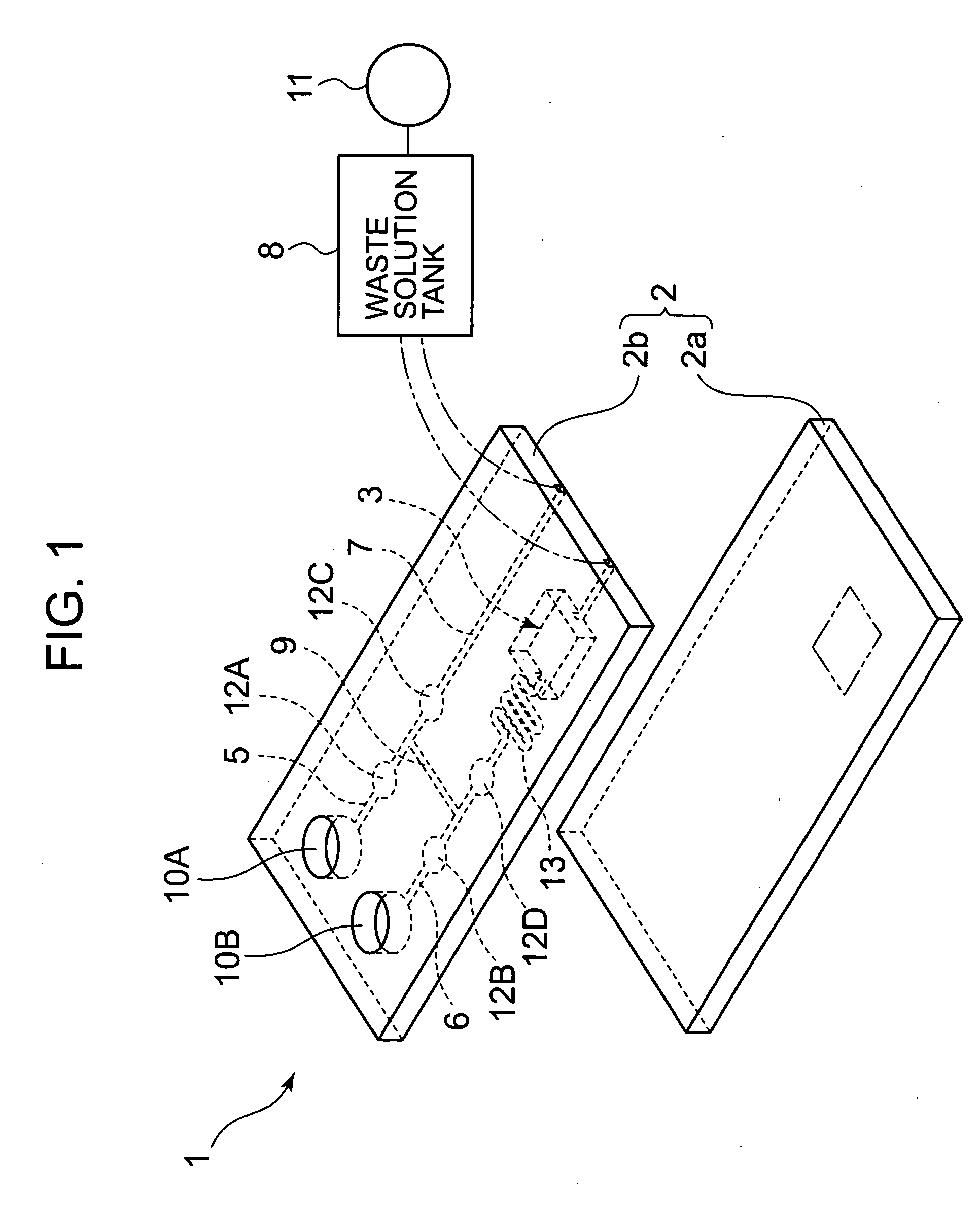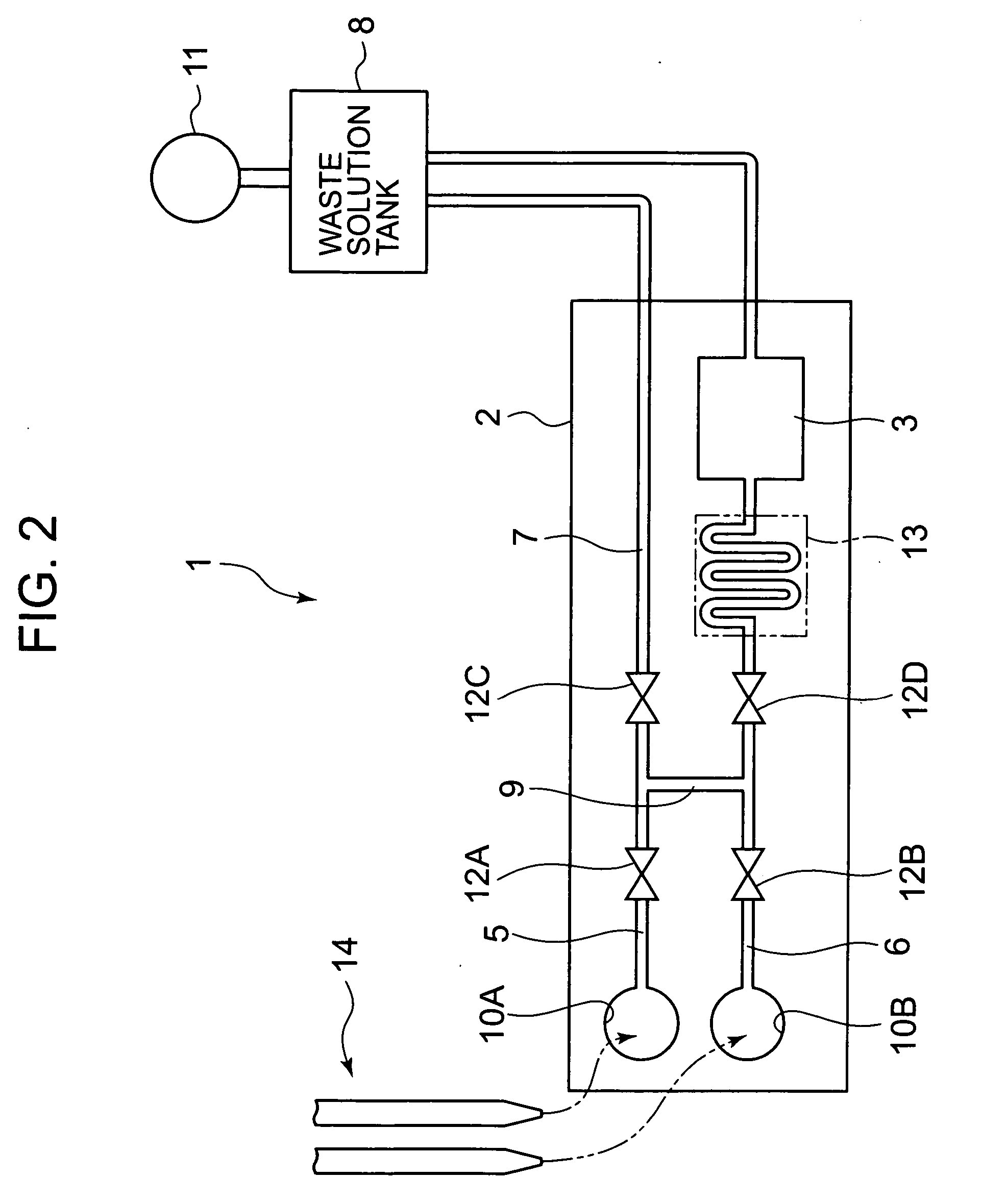Microchip for analysis, analysis system having the same, and analysis method
a microchip and analysis system technology, applied in the field of microchip analysis, can solve the problems of inability to obtain a uniform flow, product cost, and inability to complete air extraction, and achieve the effects of reducing production cost, simple configuration, and simplifying connection operation
- Summary
- Abstract
- Description
- Claims
- Application Information
AI Technical Summary
Benefits of technology
Problems solved by technology
Method used
Image
Examples
first embodiment
[0059]FIG. 1 is an exploded perspective view of a microchip for analysis 1 of the invention, and FIG. 2 is a schematic plan view of the microchip for analysis 1 of the invention. The microchip for analysis 1 of the invention is to analyze interactions of biomolecules such as protein, and in particular, to detect the state of binding reaction (for example, binding strength, binding rate, dissociation constant, and the like) between a ligand and an analyte.
[0060] The microchip for analysis 1 is provided with, on a minute substrate 2 having two plate members 2a and 2b laminated one on other, a reaction bath section 3 where a reaction is performed by mainly forming a concave portion in one plate member 2b by using photolithography or the like, a sample solution supply channel 5 which supplies a sample solution for analysis, a buffer solution supply channel 6 which supplies a buffer solution having functions of cleaning flow channels or of buffering (function of dissociation), and a was...
second embodiment
[0098] Next, a microchip for analysis 40 of a second embodiment of the invention shown in FIG. 10 will be described. The same elements as those of the microchip for analysis 1 of the first embodiment shown in FIGS. 1 and 2 are represented by the same reference numerals and thus the descriptions thereof will be omitted.
[0099] The microchip for analysis 40 shown in FIG. 10 has a configuration which is substantially identical to the four-flow channel-configuration of the microchip for analysis 1 shown in FIGS. 1 and 2. That is, in addition to the configuration of the microchip for analysis 1 shown in FIGS. 1 and 2, a buffer solution supply channel 6′ (another buffer solution supply channel) and the reaction bath section 3 are connected to form a third flow channel, the ligand solution supply channel (treatment solution supply channel) 5′ and the waste solution channel 7′ are connected to form a fourth flow channel. Further, a connecting channel (connecting channel for treatment soluti...
third embodiment
[0104] Next, a microchip for analysis 41 of a third embodiment of the invention shown in FIGS. 11 and 12 and the analysis system will be described. The same elements as those of the microchip for analysis 1 or 40 of the first or second embodiment are represented by the same reference numerals, and the descriptions thereof will be omitted.
[0105] The above-described microchip for analysis 40 of the second embodiment is such that the analysis of the sample solution is prepared by allowing the ligand solution or the treatment solution for pre-treatment solution (SAM reagent and blocking reagent) to flow in the reaction bath section 3 through each flow channel in the microchip for analysis 40. However, the microchip for analysis 40 is disadvantageous in that the configuration has defects since there are 8 flow channels, and the flow channels for the buffer solution (the first, third, fifth, and seventh flow channels) overlap one another, which results in causing the microchip for analys...
PUM
| Property | Measurement | Unit |
|---|---|---|
| flow rate | aaaaa | aaaaa |
| size | aaaaa | aaaaa |
| temperature | aaaaa | aaaaa |
Abstract
Description
Claims
Application Information
 Login to View More
Login to View More - R&D
- Intellectual Property
- Life Sciences
- Materials
- Tech Scout
- Unparalleled Data Quality
- Higher Quality Content
- 60% Fewer Hallucinations
Browse by: Latest US Patents, China's latest patents, Technical Efficacy Thesaurus, Application Domain, Technology Topic, Popular Technical Reports.
© 2025 PatSnap. All rights reserved.Legal|Privacy policy|Modern Slavery Act Transparency Statement|Sitemap|About US| Contact US: help@patsnap.com



